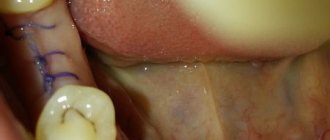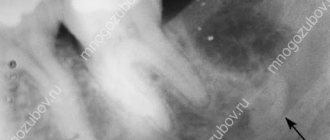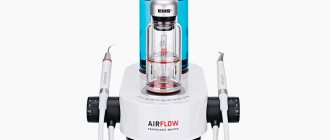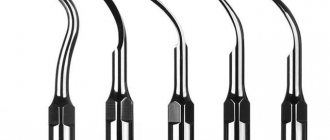Dental drainage: what it is, what it looks like
What is tooth drainage? Translated from English, “drain” means “to drain.” This is a medical instrument or device, the main purpose of which is the continuous removal of liquid contents from inflamed tissues and cavities. Usually it is inserted into open wounds and left for a short time, thus, with its help, a procedure is carried out that promotes the outflow of pus, serous exudate, blood and ichor.
This device was first invented by a French surgeon. It was originally created from materials such as glass and rubber. Today, lighter, softer and smoother materials are used for manufacturing: rubber, silicone and latex - they do not get wet, are well fixed and hold, and do not cause significant discomfort.
If you want to know what dental drainage looks like, look at the photo below. This device looks like a small thin tube, and in some cases it even looks like a thin wire, tape or just a strip of material. The device has different sizes and diameters.
Indications for installing the system in the gums
Let’s take a closer look at who gets drainage and why. Many patients consult a doctor with an acute inflammatory process and severe swelling of the tissues of the oral cavity (and sometimes even the face), caused by advanced diseases and accompanied by the appearance of a lump or abscess on the gum.
In this case, it is simply necessary to resort to surgical measures, namely, to cut the inflamed gum, as well as the abscess, and release its contents. To prevent the wound from quickly overgrown again, and to prevent pathogenic contents from remaining and accumulating inside it again, specialists place a drainage on the tooth.
So, the main indication for installing the device: a purulent-inflammatory process in the mouth caused by pathologies such as advanced pulpitis and periodontitis, gumboil, fistula, abscess, cyst and granuloma. A wide opening of the purulent cavity and drainage of pathological foci are also carried out in such serious diseases as odontogenic osteomyelitis and phlegmon [1], when the bone structures of the jaw and soft tissues of the face are affected.
On a note! The procedure is contraindicated in patients with bleeding disorders and allergies to painkillers used during the operation and the incision on the gum.
Are there any contraindications
As with any dental procedure, the procedure in question also has a number of its limitations. Among the contraindications to fixing the drainage are problems with blood clotting - in such cases, doctors try to avoid dissecting soft tissues altogether. It will also be very difficult to carry out this procedure if the patient suffers from an allergy to anesthetics.
Purulent and bloody discharge must be removed from the wound. Without this simple device it is simply impossible to cure most diseases. One way or another, the procedure must be carried out, since this is a mandatory prevention of the development of sepsis - a general infection of the body.
Drainage of the hole after the root removal procedure
Separately, it is worth mentioning situations when drainage is installed and the socket of an extracted tooth is drained. The procedure is indicated in the following cases:
- immediately after removal of a neglected and irreparable unit that has caused the appearance of an abscess in the oral cavity: if the manipulation is not performed, the likelihood of developing postoperative complications increases,
- drainage in the gums after tooth extraction is a mandatory treatment measure for those patients who have developed purulent complications during the rehabilitation period: alveolitis, gumboil, abscess,
- drainage is often installed after the removal of a wisdom tooth, and this is done to directly administer medications into the wound, which ensures rapid tissue healing and, of course, minimizes complications.
Why and when is it done: in what cases is the gum cut?
Drainage in the gum area is installed in cases where a person has an inflammatory disease of the dental system, most often it is gumboil (or periostitis) - an infectious lesion of the periosteum covering the upper and lower jaw and located just under the gum.
With flux, pus accumulates in the bone, severe swelling appears, body temperature rises, and health worsens. To help the patient, the doctor cuts the gum and places a drainage into it, through which the pus will drain out.
Very often, drainage is used after the removal of upper and lower last molars (or wisdom teeth). The operation of extracting them is often traumatic, and the teeth themselves are located near important anatomical structures - the maxillary (maxillary) sinus, the mandibular canal, and the peripharyngeal space.
Therefore, after the removal of molars, drainage is placed for a prophylactic purpose - to prevent the accumulation of blood in the postoperative wound and its subsequent suppuration. The method also allows you to reduce the size of the hematoma in the cheek and avoid facial swelling on the first and second days after surgery.
Features of the procedure
Let's take a closer look at how drainage is placed on a tooth. The procedure includes several important steps.
Stage No. 1
First, the specialist conducts a thorough visual and x-ray examination of the inflamed area to get an accurate idea of the location of the abscess, its size and depth.
Stage No. 2
The doctor administers local anesthesia so that the patient does not experience pain during the procedure. Next, at this stage, surgical intervention is performed.
If the tooth next to which the abscess has appeared can still serve, then the specialist cuts the inflamed gum with a scalpel. In cases where saving the tooth is not practical, the dentist removes its root, after which he places a tube to drain the fluid directly into the open socket (in this case, no tissue incision is made).
Stage No. 3
The opened purulent cavity is thoroughly cleaned, treated with antiseptic solutions, after which drainage is fixed in it. One end of the device is inside the wound, and the other is outside.
Next, the doctor prescribes medications, antiseptic rinses and antibiotics for home use, which, together with the installed device, will work to quickly eliminate the inflammatory process and normalize the patient’s condition.
Dentist advice
Following the recommendations increases the effectiveness of the procedure and reduces discomfort.
- After the manipulation, the patient can eat after a few hours; to reduce discomfort, it is advisable to sleep for 2-3 hours and drink a painkiller (for example, Tempalgin, Baralgin, Nise, Nimesil, Ketorol, Nurofen).
- The procedure is indicated for pus and inflammation. To avoid worsening the symptoms, do not apply warm compresses (dry or wet), drink hot drinks, or apply or bandage a handkerchief to your cheek. For better results, you can use cold - ice wrapped in a cloth, gauze soaked in cool water and applied to the cheek every couple of hours for 15 minutes. Compresses should not be applied directly to the wound, so as not to cause the spread of infection, vasospasm, or aggravate the condition.
- To avoid accidentally pulling the drainage out of the gum, you need to sleep and eat on the opposite side.
- For better healing, the patient should give up bad habits (alcohol, smoking), eat light mushy or liquid food at room temperature that does not irritate the mucous membrane.
- Carefully monitor oral hygiene, while carefully brushing your teeth near the drainage. Care should include the use of dental floss, paste, brush, rinsing with a warm antiseptic solution - soda and salt, herbal decoctions, Chlorhexidine, Miramistin, etc. It is advisable to use a soft toothbrush directly next to the device.
- Eliminate factors that provoke bleeding (physical activity, heavy lifting, sauna and bath, solarium).
- Do not injure the gums - it is important to be careful when using a toothbrush, fork or spoon. Falls and impacts can cause the drain to become dislodged and fall out prematurely.
Following the dentist’s recommendations, taking prescribed medications, timely installation and removal of drainage from the gums will help get rid of suppuration, accelerate the regeneration of soft tissues, prevent the spread of infection and the development of complications. On average, complete healing is observed 1.5-2 months after the manipulation.
Feelings after installation
Experts say that if the device is installed correctly, it should not cause any discomfort. Yes, its presence in the mouth can be felt by directly touching it with your finger or tongue. But the drainage in the tooth should not cause pronounced discomfort, rub the mucous membrane and get in the way. It is normal and correct if liquid is constantly released through it.
If you have a tooth removed and drainage installed, the sensations will, of course, be more pronounced. After all, you have undergone a full-fledged surgical operation, after which swelling, pain, a slight increase in body temperature, and difficulty opening your mouth are possible. However, all these symptoms are, to a large extent, just normal consequences of extraction (removal). But in some cases they can indicate serious complications. How to separate normality from pathology? The answer to this question is in the feature article on the site.
Duration of treatment
Many patients are interested in how long tooth drainage costs. On average, it is left for 3-6 days. During this time, all pathogenic fluid should completely leave the wound. If all is well, the patient usually feels relief within 24 hours after installation. With each subsequent day, positive dynamics are observed, swelling subsides and disappears, and the color of the mucous membrane normalizes.
It also happens that after this period, unpleasant symptoms of the disease persist, which means that the inflammatory process continues. Then doctors conduct a new examination, adjust treatment tactics and resort to other measures.
If there is drainage after tooth extraction, when can it be pulled out? The doctor decides. If the dynamics are positive, the tube is removed after 3-4 days. When the inflammatory process persists or complications of extraction appear (for example, alveolitis), the specialist pulls out the tube, performs a thorough curettage, that is, cleaning the hole, after which he can reinsert the device.
The drainage system is installed in stages:
- The painful area of the jaw is numbed.
- The gum is cut and a latex drain is inserted into it, through the hole of which the pus is sucked out.
- After suctioning out the pus, an antiseptic drug is injected into the gum incision.
- If a tooth is removed, the gum is not cut, but a drain is inserted into the socket.
How many days should I wear the drainage? Improvement may occur within 24 hours. On average, drainage costs from 3 to 5 days.
Rules to follow when having a device in your mouth
Anyone who has had drainage installed after a gum incision or tooth extraction needs to know how to behave during this period. Doctors give the following recommendations:
- you need to follow a certain diet: it is forbidden to eat hot and hard foods and chew on the side of the jaw where the intervention was performed. You need to give preference to soft and liquid dishes, drink more clean water,
- It is undesirable to sleep on the cheek on which the device is installed,
- Brushing your teeth should be done extremely carefully, avoiding the area where the tube is located: for hygiene, you can use a brush with soft bristles and a non-abrasive toothpaste. It is better to avoid using an irrigator for a while,
- Intensive rinsing of the mouth is prohibited: to carry out antiseptic and disinfectant procedures, simply take liquid into your mouth, hold for 2-3 minutes, spit it out,
- It is important to protect yourself from physical activity and sports.
What to do if the device falls out
Some patients do not even have time to find out how the tooth drainage is removed at the dentist, because the tube itself falls out of their mouth. What to do in this situation? If the system falls out in the first few days after the procedure, then you need to quickly contact your doctor to have it reinstalled. During this period, the likelihood that all the pus has come out is still too small, and the wound will heal very quickly, accordingly, pathogens will remain inside it.
If the device falls out 4-5 days after the procedure, and you notice that the swelling has subsided and pus is no longer oozing from the wound, then there is nothing to worry about. In this case, we can assume that the drainage installed for the treatment of various dental pathologies and after tooth extraction has successfully fulfilled its purpose. However, you still need to see a doctor.
Important! The main reasons for premature loss of the device: improper oral hygiene technique, active rinsing, violation of the postoperative regimen, poor-quality installation of the tube in the dental office.
Expert opinion
Elena Vladimirovna Orlova
Specializations: Dentist-therapist, endodontist
Experience: 32+
“Under no circumstances should you install drainage on a tooth yourself. You can injure the tissues or, even worse, introduce an infection into them, after which the inflammation will flare up with renewed vigor. All procedures for its installation and removal must be carried out by professional doctors under completely sterile conditions."
Indications for use
Most often, wearing drainage is recommended for flux. This disease is an inflammatory process of the periosteum, causing redness and swelling of the gums, as well as filling its tissues with pus.
Flux treatment is carried out using antibiotics, antiseptic and anti-inflammatory drugs of general and local action. However, in some cases, surgery is required. It is then that drainage is installed, which speeds up the process of removing pus, blood and serous discharge, and also promotes rapid recovery.
Installation of drainage is often required for complicated wisdom tooth extractions.
Drainage is necessary to ensure the outflow of blood and tissue fluid released from the wound, the accumulation of which can lead to infected inflammation.
Dental surgeon, periodontist
Tevs Maria Konstantinovna
7 years experience
The tube is inserted into the soft tissue through a previously made incision. The process of pumping out pus does not stop until the inflammation stops and the purulent fluids are released. In the absence of drainage, the wound quickly overgrows, so pus can remain inside, causing severe pain, elevated body temperature and other symptoms characteristic of a purulent process.
After installation, additional medications may be required to relieve the inflammatory process. In addition to general antibiotics, drugs can be prescribed that are injected directly into the tissue through drainage.
Self-removal of the structure: possible or not
Some patients experience severe discomfort, so they are interested in how to remove drainage from a tooth on their own. Others do not have time to make an appointment with a doctor on time, so they also want to know the answer to this question. Often, the dentists themselves provide detailed instructions so that the patient can perform the procedure at home. The procedure should be as follows:
- wash thoroughly with soap and disinfect your hands,
- treat the oral cavity with some antiseptic: Miramistin, Chlorhexidine are suitable,
- stand in front of the mirror, open your mouth, carefully grab the tip of the tube protruding from the wound with your thumb and forefinger and pull it towards you without force,
- rinse your mouth with an antiseptic,
- Do not consume food or drink for the next 2 hours.
“On the eve of the New Year holidays, I had a drainage installed after the removal of a dental cyst. The procedure is painless, as it is under anesthesia, but the doctor said that due to the holidays, I will have to pull the tube out of the wound myself in four days. I described in detail how this is done. When the hour struck, I was very worried, I thought it was difficult, but in fact I did everything quickly. However, after ten minutes the pain was so severe that I had to take pills. But within a day I even forgot that I once had this tube. After the holidays, I saw the doctor, he said that I was good, and the tissues were healing normally!”
Irina R, review from 32top.ru
The procedure is simple, but if the device has not fulfilled its main purpose, then it should not be carried out under any circumstances. And, in general, even if your condition has improved significantly, you should not resort to independent measures without consultation with a specialist. It is better to have a professional doctor perform all steps to remove the device. Why? Removing the tube yourself can cause severe pain, prolonged bleeding, damage blood vessels and injure surrounding tissue.
What you can do yourself
If you don’t have time to go to the doctor a day after surgery and remove the drainage, you can remove it yourself:
- It is necessary to wash your hands thoroughly with soap and rinse your mouth with distilled water.
- Take clean tweezers and thoroughly wipe their tips with alcohol. Vodka or cologne can be used as a disinfectant.
- Use tweezers to grab the edge of the graduate, which lies freely in the mouth, and gently and smoothly pull it towards you.
- The wound must be covered with a sterile gauze pad for 20 minutes.











